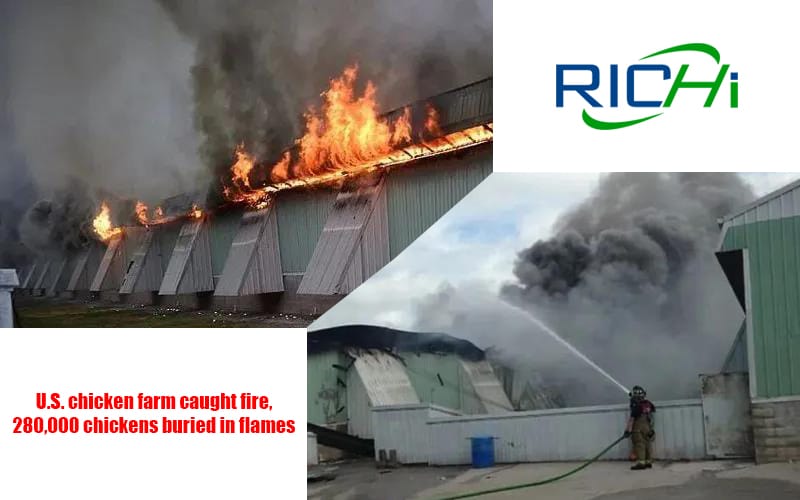
Henan Richi Machinery Co., Ltd publishes the news about company and industry. Welcome to learn about the latest news here.

Recently, a three-storey chicken house in a chicken farm in California caught fire. The fire was very fierce. The fire was soaring, the smoke was rolling, and the whole chicken house collapsed. None of the 280,000 chickens raised inside were spared. In fact, fire accidents in chicken farms are not uncommon in the United States. For example: in July 2017, a fire swept through a chicken house in a chicken farm in Pennsylvania, USA, causing more than 100,000 layer hens to be burned alive and causing heavy losses; January 4, 2020, a building in southwest Michigan A fire broke out in a poultry chicken farm, and about 300,000 hens were burned to death.
1. What is the cause of the accident?

Judging from the picture, the chicken coop area is not large, but there are nearly 300,000 chickens in captivity inside, which is unbelievable! For a long time, some large chicken farms have been driven by interests, and the overloaded captivity of chicken coops has been criticized by American society.
2. Why do fires occur in chicken houses that are overloaded?
The most likely fire risk point is that combustible gases such as ammonia and hydrogen sulfide exceed the standard. Both of these gases are flammable and explosive and will detonate immediately when they reach a certain concentration in the air. However, the lower explosion limit of ammonia is 15% and hydrogen sulfide is 4.3%. Therefore, it is not easy to reach the gas concentration required for explosion. So where is the high concentration of ammonia and hydrogen sulfide in the chicken house?
(1) Waste such as feces and feathers
A chicken house is crowded with tens of thousands, or even hundreds of thousands of chickens. If the house is not cleaned up in time, the feces and feathers of the chicken are easily decomposed and deteriorated, which is decomposed by microorganisms to produce ammonia gas and hydrogen sulfide. Both of these are combustible gases, so it is not difficult to imagine that hundreds of thousands of chickens are housed in a chicken house, and their excrement will produce ultra-high concentrations of combustible gas.
(2) Mattress
The cushions laid in the chicken coop are generally made of sawdust, sawdust, grass and other highly absorbent materials. When the temperature and humidity in the chicken house are too high, the mat will absorb a lot of water and become very humid, accelerate the rotting of chicken manure, and cause the concentration of ammonia and hydrogen sulfide to rise rapidly in a short time.

(3) Ventilation facilities
According to the local weather forecast, the lowest temperature in California is 12 degrees Celsius. Some chicken farms are worried that the chickens will be affected by cold and freezing, which will affect the production. Therefore, they cannot do enough ventilation and ventilation, which will increase the concentration of combustible gas.
In summary: chicken manure, chicken house bedding, and ventilation in the chicken house are all important risk points for fire and explosion. Of course, there are other fire risk points in the chicken house, such as dust explosions such as dust and feed debris.
3. How to deal with hidden dangers and prevent them from happening?
How to deal with manure of chickens and other livestock and poultry, waste from farms, and improvement of pen environment?
Manure treatment equipment can effectively solve the waste disposal problems faced by aquaculture plants; organic fertilizer pellet production lines and supporting facilities have truly realized the theme of turning waste into nutrients.
What is manure treatment equipment? How to realize the production process of organic fertilizer particles from manure to chicken farm?

(1) Compost fermentation
Collect all kinds of livestock and poultry manure for production and living, and mix them according to a certain ratio after pretreatment. The humidity of the mixture is about 60% (humidity suitable for fermentation). Add biological strains to make it ferment. Faster and more complete.
(2) Crushing: The crushing object is the material after the fermentation is completed, the humidity is relatively dry, in order to meet the requirements of granulation, the output particle size should be less than 0.5mm, the finer the easier the granulation.
(3) Screening of materials:
A . sieve out all the fine materials as much as possible;
B. sieve the fine materials directly to the next step;
C. collect the screened slag and crush it again.

(4) Mixing: According to the requirements of the new organic fertilizer pellet makingmachine, the moisture of the material is adjusted, generally between 30% and 35% , both to ensure the molding and the production speed.
(5) Granulation: the particle size is uniform, the molding rate is high, and it must meet the output requirements.
(6) Drying: The prepared chicken manure organic fertilizer pellets are transported to the dryer, and the fertilizer is dried by using the large air volume produced by the fan and the temperature after being treated by the jet air inducer.
(7) Cooling: The finished pellets are transported to the organic fertilizer cooler, and the fertilizer is cooled by natural cold wind or strong cooling wind.
(8) Screening of particles: Too small or too large pellets will return to the previous stage to re-granulate.

View Richi Machinery's organic fertilizer pellet production line: https://www.cn-pellet.com/solution/wood-pellet-production-line/organic-fertilizer-pellet-line.html
For more questions about animal chicken poultry manure organic fertilizer pellets, please feel free to consult Richi Machinery!

For all inquiries fill in the form below to send us a brief message,and we will get back to you as soon as possible

RICHI stick to the service principle is: We are focusing on your future, your future is our future!
© HENAN RICHI MACHINERY CO., LTD 1995-2025
Product Line-Up / Privacy Policy